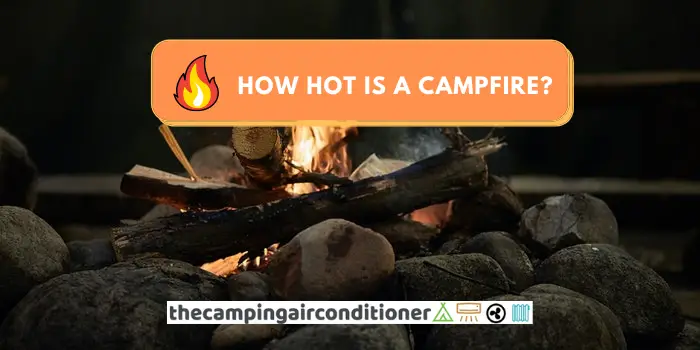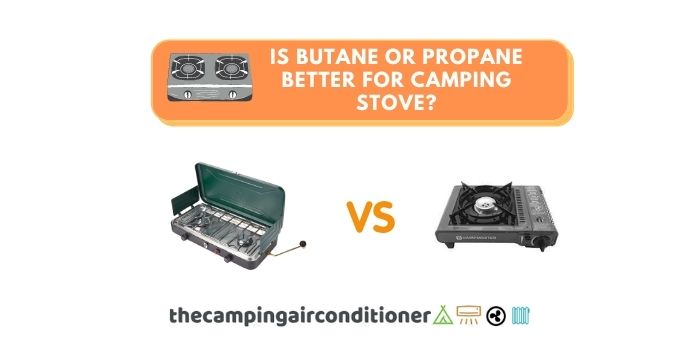A campfire is one of the highlights of going on an outdoor adventure – it helps to warmly gather campers while they share a delicious meal, tell each other about their life experiences, or simply appreciate the beauty of a clear night sky.
Many campers have asked us which firewood is best for camping? Overall, hardwoods, such as oak, hickory, and fraxinus (aka ash), are the best option for campfires since they can burn longer and offer a better heating output.
The best choice for you will also rely on other aspects, such as availability in your area and price – let’s go through in detail what you should look for when picking up firewood for your next camping trip.
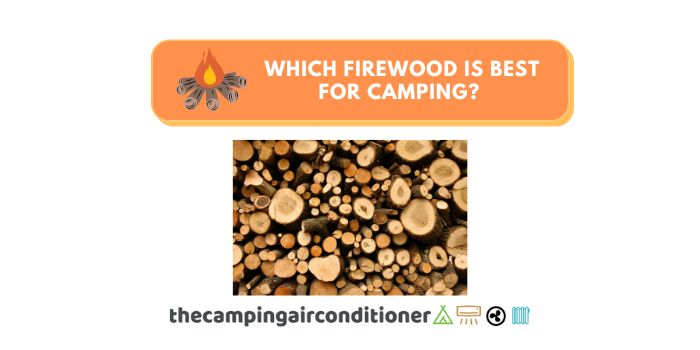
Hardwood vs Firewood - What type of firewood is the best for a campfire?
With different types of trees existing and growing under different conditions, it is natural to think each wood will have distinguished characteristics.
Overall, we can divide firewood into softwood and hardwoods. Hard than characterizing by how “hard” they are, this terminology actually refers to how dense the wood is.
Softwood is known to be “lighter” and has a lower density. In practice, this means that it burns faster and has hotter and higher flames.
On the other hand, hardwoods are heavier and denser, providing more heating output and burning flames for longer than their lighter sister – hardwoods tend to burn slower and at a steady pace.
Hardwood is typically harvested from slow growers’ trees, which provides them with more time to produce strong and denser fibers.
Which firewood is best for camping then?
As discussed above, hardwoods are the best type of wood to burn. But with many variations, what are the best options? The table below summarises some features for each type of wood (Adapted from firewood facts – New Mexico State University) .
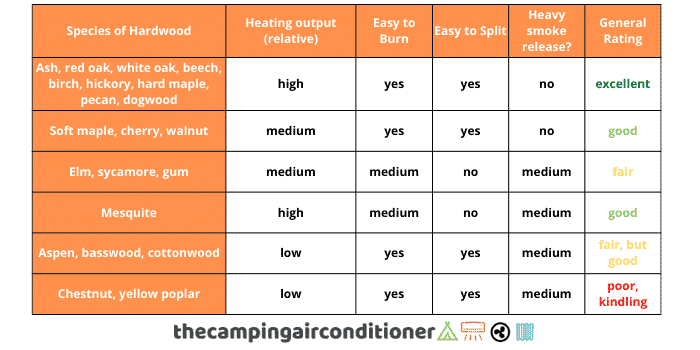
When choosing the best firewood for your camping adventure, you should take into consideration some aspects, such as:
- Availability: some species might not be available in your area.
- Heating output: – how much heat can that specific wood provide (the higher, the better)
- Ease to split: can you split the wood easily? This might be important if you bring big logs for multiple days/weeks of camping.
- Smoke: How much smoke does that wood generate? We prefer less smoky options.
From the table above, we note that the best hardwoods are:
- ash,
- red oak and white oak
- beech,
- birch
- hickory
- hard maple
- pecan, and
- dogwood.
Other options are still good, but these are the top choices for a camper.
This second table summarises the characteristics of the best hardwoods for a campfire and the following paragraphs present a brief summary of each type of wood.
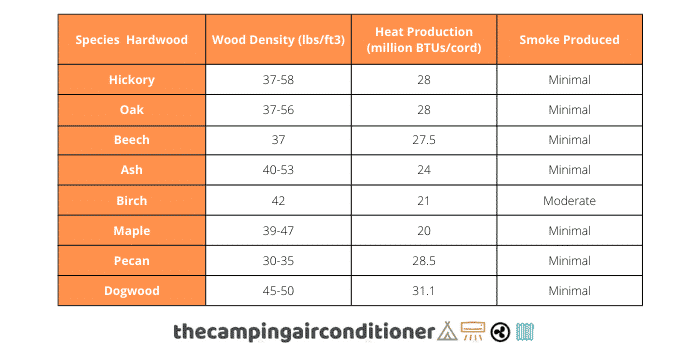
Note: A cord is a unit to measure stacked firewood, which measures 4 x 4 x 8 feet (128 cubic feet).
Hickory
Hickory has high density, being one of the best firewoods to burn. It provides an excellent heating output (28 Million BTU/cord) and can burn hotter than oak and maple.
It is broadly used for cooking by campers because of its slow burn and low flames. Further, it produces minimal smoke and does not cause breathing problems.
Oak
Oak is broadly known for its strength and the production of wine barrels. It can produce a large amount of heating when it is dry and, like other hardwoods, burns slow.
One of the biggest advantages of this species is its availability – it can be found across different areas of north and central America and has more than 600 different subspecies (red oak, white oak, and so on)!
Beech
Beech trees are usually tall and rounded. Its density is not as high as hickory, which means a beech campfire will typically last shorter than a hickory’s.
It still produces a considerable amount of heating output (27 Million Btu / cord) and minimal smoke. Overall, even though it is suitable for firewood, it requires a longer seasoning time than other hardwoods to achieve optimal conditions.
Ash
Ash provides an excellent relationship between heating output (24 Million BTU / cord) and weight. It burns clean, with almost no sparks and smoke release – an excellent option for cooking.
These trees have a neutral aroma and will not create strange smells while you handle and burn them. Pay attention; sometimes, you can find some sap dipping from ash logs. With more than 60 species, these trees are found in the northern parts of Europe, Asia and North America.
Birch
Conversely to the other species in this list, birch tends to produce moderate smoke when it burns. Also, when it comes to heating output (21 Million BTU / cord), it only expels more than maple, being the second last option.
Among its advantages, we can highlight the ease of splitting, clean-burning, and less sticky sap. It also has a medium to high density, meaning that your campfire will last long.
Maple
Maple, which is also known as a Canadian symbol, is another hardwood option. Out of the options detailed in this article, it produces the least amount of heat (20 Million BTU / cord), which is still considered good but not as excellent as hickory or dogwood.
With a medium-to-high density, it will produce good flames to cook your preferred meal or keep your night warm. Pay attention, though: there are two major categories of maple – hardwood maple and softwood(red) maple, which perform significantly worse than the hardwood version – producing less than 18 million BTU / cord.
Pecan
Pecan has great coaling features and burns long and hot! It is a species of the hickory family, but it is less dense (30-35 lbs per cubic foot). Some campers praise the aroma released by these logs and their low smoking output.
As for heating, it releases approximately 28.5 million BTU per cord, being one the best firewood options for your next camping adventure.
Dogwood
Dogwood is another excellent option for firewood – it comes with great density and the highest heating output on our list. Further, it produces minimal smoke, and its flames will last long!
Some campers complain about the ease of splitting of this species and the overwhelming smell. However, its features outweigh these minor details, in our opinion.
How much wood do I need for my campfire?
The truth is – it depends on the size and how long you want to make it last.
Overall, we recommend from 2 to 4 bundles (a typical bundle will contain 4-6 pieces of firewood – approximately one cubic foot) of hardwood to make your campfire last around 4 hours.
If you want it to last longer or are camping for many days, you will need more wood. If you don’t have too much space to transport wood logs, you can consider a camping heater to keep you warm or a propane or butane camping stove to cook.
Varying between both solutions might be a good approach!
Can I burn softwood in my campfire?
Yes, you can. Even though hardwoods are generally better, softwoods can be a good option when you need to ignite your campfire quick or when you need taller flames.
Overall, their high burning flames are most commonly used for heating only and not cooking (you can roast your marshmallow, though!). Its fast ignition comes from its low sap content, making it much easier to start a fire.
Among the options, you can choose from pine, balsam, spruce, cedar, tamarack, alder, and poplar.
How to stack firewood?
First of all, you should always try to keep your wood dry. Therefore, preferably store it under a covered area with no rain exposure, such as below a tree and covered with a tarp or plastic cover.
To ensure stability, stack in a crosswise pattern and with some space between the logs so that air can flow and keep the wood dry in case of moisture in the area.
How to make your firewood last longer?
A couple of measures will help your campfire goes longer, such as:
- Use dry firewood (with moisture levels less than 20% – use a wood moisture meter to check it)
- Use hardwood instead of firewood.
- Use a few rocks in your campfire – yes, rocks are excellent heat conductors and can keep heat, making your campfire last longer.
- Keep ventilation going (oxygen is essential for wood combustion)
- Build a top-down campfire, with larger logs on the bottom base and smaller pieces on top.
If you want to know how to keep your hot tent stove burning all night, read this article – How do you keep a hot tent stove burning all night? (3 easy steps!).
What is the best firewood for cooking?
Almost all dry and seasoned hardwoods – maple, oak, hickory, birch – will be a good choice for cooking because of their slow-burning features and low smoke production.
Softwoods will produce higher flames, being, therefore, not ideal for preparing your meal.
Conclusion
As detailed in this article, hardwoods are the best option for your campfire – they burn longer and with more controlled flames.
Softwoods can also be used but will produce higher flames, produce less heating output, and last shorter than hard species.
After all, our recommended choices for firewood are:
- ash,
- red oak and white oak
- beech,
- birch
- hickory
- hard maple
- pecan, and
- Dogwood.

